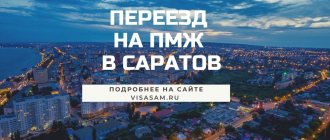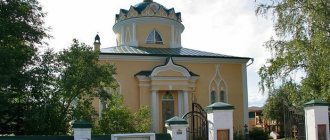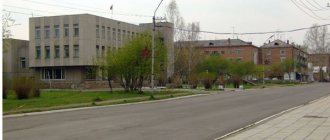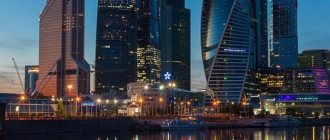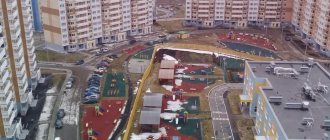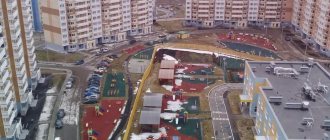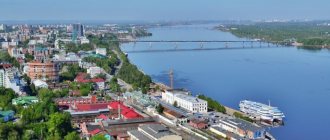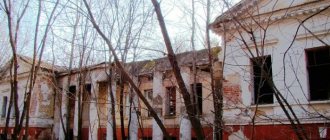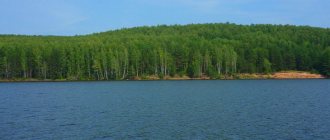The location of the Stavropol Territory in the central zone of the Ciscaucasia territory makes it one of the most popular subjects of the Russian Federation for balneotherapy. It includes the resort towns of the Kavminvod region, popular since the 19th century, where Narzan, Essentuki No. 4 and Essentuki No. 17, known to all residents of the post-Soviet space, are mined. The region cannot be called large: on a national scale, it is in 45th position in terms of area: the value is 66,160 km². It is also in 15th place in terms of population: the figure for 2018 is 2,795,431 people. The density is also relatively low: 42.25 people/km² - 23rd place in the Russian Federation. For comparison, in the Moscow region this figure shows 171.36 people/km². In 2012, for the first time since 1995, researchers recorded an increase in the natural population, which previously was carried out only by visitors.
Content
- 1 Large cities 250 - 500 thousand people 1.1 Stavropol
- 2.1 Pyatigorsk
- 3.1 Mikhailovsk (Stavropol Territory)
Kislovodsk is third on the list
Kislovodsk is the center of the Kavminvod resort area, where a third of all health resorts in the region are located. Thanks to the famous Kislovodsk Park, the largest man-made park in Europe, there is an excellent climate and clean air. However, Kislovodsk is famous for its mineral springs, the acidic waters of which gave the city its name - “Narzan”, popular throughout the country. After Sochi, this settlement is in second place in importance as a balneological and climatic resort.
Since only 129,593 Kislovodsk residents live in the resort city, and the density is 1,799.9 people/km², it is never crowded even with an influx of tourists. Most of the town's territory is occupied by the Kislovodsk Park, with an area of more than 900 hectares, where resort guests enjoy the natural beauty and master the routes of health paths. The population dynamics are unstable. Every 3-4 years the direction of the value changes: it either increases or tends downwards. Because of this, from 2002 to 2022 the parameter remains at about 129,000. Among the main problems is the low supply of kindergartens: only 421 places per 1,000 children.
Large cities 100-250 thousand people
Pyatigorsk
Population 145,448 people (2016).
Coat of arms of Kislovodsk
Administrative center of the North Caucasus Federal District. It is part of the polycentric agglomeration of the Caucasian Mineral Waters.
Kislovodsk
Population 129,993 people (2016).
It is part of the polycentric agglomeration of the Caucasian Mineral Waters.
Coat of arms of Nevinnomyssk
Nevinnomyssk
Population 117,891 people (2016).
Coat of arms of Essentuki
Essentuki
Population 105,881 (2016).
It is part of the polycentric agglomeration of the Caucasian Mineral Waters. The administrative center of the specially protected ecological resort region of Caucasian Mineral Waters.
Largest cities in Stavropol region by number of inhabitants
The region is dominated by the urban population: 58.56% of the total population living in the Stavropol region. At the same time, over the past few decades, the trend towards an increase in the number of city residents against rural residents has continued.
The national composition of Stavropol is varied, due to the region's location in the Caucasus. Since ancient times, many related peoples lived here, but with their own national self-identification. Despite the fact that about 80% are Russians, more than 20 nationalities neighbor them, each numbering more than 1000 people. Among them:
- Dargins;
- gypsies;
- Azerbaijanis;
- Armenians;
- Ukrainians;
- Greeks;
- Ossetians;
- tabasarans;
- Abazins;
- Karachais;
- Tatars;
- Kabardians;
- Turks;
- Lezgins and others.
On the list of 19 cities in the region, there is not a single one with a population of less than 20,000 people. At the same time, some villages, villages and towns can boast of a larger number of inhabitants than cities. For example, in the village of Inozemtsevo there are 27,502 residents, and in the smallest city of Ipatovo - 24,021. Only the main city of the region, Stavropol, can be called large, where 433,931 people live.
The list of the most densely populated in the Stavropol region includes:
- Stavropol - 433 931.
- Pyatigorsk - 145,885.
- Kislovodsk - 129,593.
- Nevinnomyssk - 117,446.
- Essentuki - 108,679.
Medium-sized cities 20-100 thousand people
Mikhailovsk (Stavropol Territory)
This name has other meanings, see Mikhailovsk
Population 85,387 people (2016).
Mineral water
Population 75,620 people (2016). It is part of the polycentric agglomeration of the Caucasian Mineral Waters.
Georgievsk
Population 69,944 people (2016). It is part of the polycentric agglomeration of the Caucasian Mineral Waters.
Budennovsk
Population 62,964 people (2016).
Abundant
Population 38,409 people (2016).
Svetlograd
Population 37,515 people (2016).
Zelenokumsk
Population 35,568 people (2016).
Grateful
Population 31,558 people (2016).
Novoaleksandrovsk
Population 27,067 people (2016).
Novopavlovsk
Population 26,295 people (2016).
Zheleznovodsk
Population 25,126 people (2016).
Neftekumsk
Population 24,958 people (2016).
Ipatovo
Population 24,782 people (2016).
Lermontov (city)
There are other meanings of this name
Population 22,635 people (2016). It is part of the polycentric agglomeration of the Caucasian Mineral Waters.
Stavropol is the largest in the region
Stavropol is the largest in the region and one of the largest in the North Caucasus region. Despite the fact that the number does not reach a million with a value of 433,931, the density is quite high and amounts to 2527.26 people/km²: two times less than in Moscow and a thousand more than in Kyiv.
In terms of the number of citizens, it ranks 45th out of 1113 possible. One of the largest jumps in the increase in the number of residents in recent years occurred in the period 2009-2010, when the figure increased by 30,000 in one year. The national composition approximately coincides with that characteristic of the entire region. This is the main industrial and cultural center of the Stavropol region, which has repeatedly received the title of the most comfortable in the Russian Federation.
see also
- Stavropol region
- Cities of Russia
| [ + ] Cities by regions of Russia | |
| Cities of the North-West (NWFD) | St. Petersburg (and its cities) • Leningrad region (historical Staraya Ladoga) • Arkhangelsk region • Vologda region • Kaliningrad region • Karelia • Komi • Murmansk region • Nenets Autonomous Okrug • Pskov region |
| Cities of the Volga region (Volga Federal District) | Bashkortostan • Volgograd region • Kalmykia • Kirov region • Mari El • Mordovia • Nizhny Novgorod region • Orenburg region • Penza region • Perm region • Samara region • Saratov region • Tatarstan • Udmurtia • Ulyanovsk region • Chuvashia |
| Cities of Southern Russia (SFD) | Sevastopol (including Inkerman) • Republic of Crimea • Adygea • Astrakhan region • Krasnodar region • Rostov region |
| Cities of the North Caucasus (NCFD) | Dagestan • Ingushetia • Kabardino-Balkaria • Karachay-Cherkessia • North Ossetia - Alania • Stavropol Territory • Chechen Republic |
| Cities of the Urals (Ural Federal District) | Kurgan region • Sverdlovsk region • Tyumen region • Khanty-Mansi Autonomous Okrug - Yugra • Chelyabinsk region • Yamalo-Nenets Autonomous Okrug |
| Cities of Siberia (Siberian Federal District) | Altai Republic • Altai Territory • Irkutsk Region • Kemerovo Region • Krasnoyarsk Region • Novgorod Region • Novosibirsk Region • Omsk Region • Tomsk Region • Tyva • Khakassia |
| Cities of the Far East (FEFD) | Amur Region • Buryatia • Jewish Autonomous Region • Trans-Baikal Territory • Kamchatka Territory • Magadan Region • Primorsky Territory • Sakha (Yakutia) • Sakhalin Region • Khabarovsk Territory • Chukotka Autonomous Region |
| see also | Cities of the DPR, LPR, Transnistria, South Ossetia • Regions of Russia • Cities of Russia |
TOP 5 best cities in the Stavropol Territory for living
The Stavropol Territory is located near the Krasnodar Territory, Rostov Region, Kalmykia, Dagestan and Chechnya. The region is part of the North Caucasus District and is a subject of Russia. The population is 2.8 million people, which is why it is awarded 15th place in the Russian Federation. The characteristics of the Stavropol Territory are less bright than those of the Krasnodar Territory, but still, the region is warm and with magnificent nature. People often say this about the beauty of landscapes: “The houses are charmingly surrounded by dense greenery.” There is also a lot of talk about the numerous mineral springs. Today the region has been given the status of a “natural and recreational center” of federal significance.
If you dream of living in an area surrounded by dense greenery, with warm winters, close to health resorts, it is worth exploring the best cities of the Stavropol Territory. In 2022, the top 5 included Stavropol, Essentuki, Pyatigorsk, Mineralnye Vody, and Kislovodsk.
Stavropol
Stavropol is the main city of the region, valued for its business and cultural qualities. It is also an industrial and commercial center that provides its citizens with jobs and income. It is considered the average settlement in Russia, since the population is around 450 thousand people. In Stavropol, there are about 90% Russians, 10% are other nations: Armenians, Greeks, Chechens, Ukrainians, Belarusians.
Advantages
First of all, Stavropol is valued for its historical heritage. Previously, the city was a fortress formed by the Russian commander Alexander Suvorov. In this connection, the “Stone Cross”, erected on Cathedral Hill in his memory, became the symbol of the city. An amazing place that attracts thousands of guests from all over Russia.
You will like living in Stavropol because of the following advantages:
- Rich region and rich neighborhood. Steppe valleys, forested area, Komsomolsky pond, Cold mines, Novotroitskoye reservoir, thermal springs. If you want to go to the Black or Azov Sea, then there are excellent transport connections with Anapa, Gelendzhik, Novorossiysk. With such natural diversity, you can spend your free time very pleasantly and with health benefits. There is no need to wait for a vacation, a weekend is enough.
- Availability of International Airport. A. Suvorov. It’s easy to get out to other cities in Russia to visit relatives or friends, and also go on a trip abroad. Airplanes often fly to Moscow, St. Petersburg, Sochi, and Istanbul, especially during the holidays.
- A well-kept city with architecture, monuments, and squares characteristic of the region. In general, there is an atmosphere of a modern city, but with an imprint of history. This interweaving of old and new always fascinates and inspires.
To add to the list of advantages, it should be added that Stavropol is often included in the ranking of the most comfortable cities in Russia. In terms of infrastructure, the presence of a large number of preschool, school and higher education institutions, a trading network and industry development.
Work and salary
There is nothing wrong with jobs in Stavropol; there are enough of them to employ locals and those who have moved. There are large enterprises in mechanical engineering, radio-electronic equipment, and high technology. The food industry is well developed. By the way, the entire Stavropol region is famous for its grain fields, so the fertile land also favors the relocation of lovers of gardens and vegetable gardens.
The average salary is 35 thousand rubles, common is 30 thousand rubles. Workers are required in trade, construction, IT, and service sectors. Here are the salaries of some specialists in 2022:
| Vacancies | Salary |
| Vols construction installer | 80 000 |
| VET engineer | 50 000 |
| Cartridge refiller | 30 000 |
| Electromechanic | 25 000 |
| Cashier operator | 30 000 |
| Commodity expert | 30 000 |
| Shop assistant | 28 000 |
| Factory worker | 30 000 |
| Machine operator (rotational shift) | 97 000 |
| Banking specialist | 37 000 |
Real estate
Stavropol contains the center, old areas and new complexes. Every day the city is growing and there are more and more opportunities to move to improved housing. Fortunately, the housing stock here is very diverse, which is a huge plus. You can buy an apartment or a house with any capital; there are even offers on the market for 500 thousand rubles. Average price 56,000 per sq.m.
Prices
The cost of the consumer basket is estimated at 20 thousand rubles. for one person. For a family of 2 people 41 thousand rubles. Prices for products in rubles:
- eggs – 80;
- bread – 26;
- milk – 58;
- cheese (1kg) – 400;
- meat from 240-350;
- fruits – 60-85;
- vegetables – 27-60.
There are many retail outlets in Stavropol, including popular all-Russian hypermarkets.
Details about the best areas of Stavropol...
Essentuki
Essentuki is a resort in the North Caucasus District, at the same time it is protected as an ecological region of the Caucasian Mineral Waters. For the most part, people are interested in it for medical and health purposes; on its territory there are over 30 sanatoriums, boarding houses, and health resorts. Most often, pensioners or people tired of busy city life move from other regions for permanent residence. The population in 2022 was 115 thousand people and it must be said that every year the figure increases by 2 - 3 thousand. Russians predominate, there is a diaspora of Greeks and Armenians.
Advantages
Back in the nineteenth century, Essentuki became famous thanks to its natural finds. Wetlands with useful water were found, which later became a significant drinking resource. Today, there are about 7 mineral water bottling plants operating in the city, supplies of which go to all regions of Russia and the nearest Republics.
Some Russians find the following advantages for moving to Essentuki:
- An environmentally friendly place to live. Within the city there are two large parks with flower alleys combined with majestic trees. As the settlers write: “Finally, I’m breathing in fresh air deeply and everything in the area is so beautiful.” There is no heavy industry here. Therefore, there is not much pollution, only exhaust from transport and wastewater.
- Pleasant architecture in Greek and English style, intersecting with interesting buildings of Slavic antiquity and modernism. Fountains, a theater platform, sculptures, a local history museum, spring galleries, a convent, a temple complex - all this gives the city its originality and originality.
- The climate is close to the southern continental. Full hot summer, warm spring, slightly frosty winter, cloudy autumn. An ideal picture for Russians who dream of getting rid of the many gloomy and cold days of the Northern region.
After moving, new residents emphasize the picturesque nature of Essentuki, as well as a quiet and comfortable life.
Work and salary
The labor market has its own specifics. First of all, the infrastructure was created for the improvement of guests and, as already mentioned, for the purposes of balneological treatment. Accordingly, workers are required in the field of medical and hotel services, the retail sector and catering. There are cozy restaurants, hotels, and a few entertainment venues where you can find work with relevant experience. There are bakeries, dairy and sausage shops, beer and cognac factories. Also sewing, knitting and shoe factories. There are enough retail stores and markets, there are hypermarkets, including Magnit.
The average salary is around 32 thousand rubles, but it is not uncommon when they pay 15 thousand rubles. In this regard, if you are not satisfied with the job offer or salary, you can get a job at an enterprise in the city of Pyatigorsk. The distance to there is only 18 km.
In the summer, salaries for professions related to tourism, restaurant business, trade, and taxis are always higher. During periods of calm, when there are few tourists and guests, incomes drop sharply. In the summer of 2022, employers are posting advertisements for the following:
| Vacancies | Salary |
| Tourism administrator | 40 000 |
| Shop assistant | 35 000 |
| Handyman | 40 000 |
| Part-time cleaner | 8 000 |
| Installer of PVC structures | 62 000 |
| Bus driver | 30 000 |
| Taxi driver | 66 000 |
| Loader-packer (on shift) | 155 500 |
| Waiter | 50 000 |
| Senior accountant | 40 000 |
Real estate
Development of vacant territories is underway in Essentuki: 16 new residential complexes have been built. They are intended for comfort-class housing and office space. Elite apartments with panoramic views of picturesque places have appeared, as well as comfortable cottages. The secondary market is also diverse: there are old houses and buildings from 2000, private houses. In the new complexes, an apartment of 44 sq. m. m. is sold for 2.4 million rubles, three-room apartment of 92 sq. m. m. - for 4.8 million rubles. Budget housing includes rooms for 500 thousand, apartments from 1 million, land plots for 200-300 thousand rubles. The urban area is developed on the left bank of the Podkumok River and is divided into microdistricts.
Prices
The cost of the consumer basket is also estimated at 20 thousand rubles. for one person. For a family of 2 people 41 thousand rubles. Food prices in rubles:
- eggs – 36;
- bread – 26;
- milk – 25;
- cheese (1kg) – 175;
- meat from 120-240;
- fruits – 30-45;
- vegetables – 27-60.
Pyatigorsk
Those wishing to move to the Stavropol Territory may deservedly like Pyatigorsk, there are many reasons for this. Firstly, it is a modern city and at the same time a medical resort. Secondly, there are many iconic places erected in memory of Mikhail Lermontov, Ostap Bender and other literary and film figures. This combination of historical and cultural heritage shows the diversity of Pyatigorsk, and it should be said that its residents rightfully have something to be proud of. In addition, the resort city is classified as a protected area due to its valuable mud, mineral waters, and green areas. The population in 2022 is 146 thousand people.
Advantages
It is better to live in Pyatigorsk for the following reasons:
- The infrastructure of the city is very clear, because it is a modern resort. There are large retail chains, well-developed transport, housing for every budget, many catering establishments, cinemas, museums, etc.
- Large selection of educational institutions, including preschools. In 2022, there are 18 universities, 36 kindergartens and 29 secondary schools. In addition, there are sports sections for both children and adults.
- Beautiful nature and a pleasant climate will also create a cozy environment for those moving. Mountains, steppe expanses, forest parks, a large number of reservoirs. Two mountain peaks Beshtau and Mashuk, reigning over the city. There are clearly 4 seasons - hot summer, friendly spring, mild winter and comfortable autumn.
Many nationalities live in Pyatigorsk, 70% of Russians live there, approximately 15% of Armenians and other peoples - Greeks, Azerbaijanis, Ukrainians.
Work and salary
Pyatigorsk belongs to the resort area, therefore the entire labor market is focused on serving tourists and residents. There are food industry enterprises, the food market is well developed, there are design and construction companies, and companies operate in the service and logistics sectors. This includes the banking sector and insurance. In terms of cultural activities, it is worth highlighting the presence of theatre, museums, cinemas, and local musical groups. After moving to the best city of Pyatigorsk, you can find work in various fields. In total, 400 enterprises are registered. The average salary is 35-40 thousand rubles.
Today in Pyatigorsk they offer the following places to work:
| Vacancies | Salary |
| Delivery driver | 90 000 |
| Seamstress compilation | 50 000 |
| Storekeeper-picker | 45 000 |
| Carpenter furniture maker | 40 000 |
| Salesman-cashier | 50 000 |
| System Administrator | 45 000 |
| Realtor | 70 000 |
| Account Manager | 40 000 |
| Bank consultant | 37 000 |
| Office Manager | 30 000 |
Real estate
Pyatigorsk is divided into the center, resort and sleeping areas, including the nearest towns and villages. Why real estate for every taste and budget. At the same time, new housing is being built, designed to the most modern standards. Based on reviews from those who moved, it is clear that the North-Eastern part is quite remarkable for settlement due to its excellent infrastructure and transport accessibility. The cost of real estate starts from 50 thousand rubles. per sq. m.
Prices
In the Stavropol Territory, the difference between cities is plus or minus 10%, which is insignificant. In the current period in Pyatigorsk, prices for basic products are as follows:
- eggs – 45;
- bread products – 15;
- dairy products – 25;
- cheeses – 175;
- various meats from 125-240;
- seafood – 50;
- fruits – 30-80;
- vegetables – 22-50.
Mineral water
The Mineralnye Vody resort is included in the list of the top 5 best cities in the Stavropol Territory. The name accurately describes the subject of Russia. A health resort city that has been loved by many since the times of the USSR and up to 300 thousand Russians still come here every year. The main wealth of the resort is its mineral springs, original in diversity and healing properties, and deposits of medicinal mud. The sanatoriums provide treatment according to medical rules. The population is 73 thousand people, most of them are Russians, but Armenians and Greeks also live.
Advantages
The city of Mineralnye Vody is suitable for living due to the following advantages:
- The climate is close to southern with all the ensuing consequences. All seasons are easily tolerated by people of different ages. Winter without snowfalls and low temperatures, summer and spring are the most favorable seasons.
- Availability of International Airport and Railway Station. Air communication with Moscow and St. Petersburg has been established; during the tourist season, additional planes fly to Yekaterinburg, Perm and other Russian cities. Charter flights are operated to Turkey, the UAE, and Egypt.
- Clean air, wealth of natural resources. Living better and healthier in an ecologically clean area, Mineral Waters can boast of all this.
It should be emphasized that the infrastructure is quite comfortable, there is enough public transport, kindergartens, schools, and gymnasiums. It is more convenient to obtain higher education in Pyatigorsk, which is located 20 km away.
Work and salary
There are over 30 companies located in the city of Mineralnye Vody, mainly engaged in the service sector, food industry and medical tourism. Retail networks are well developed: there are hypermarkets, Magnit, shopping centers, construction stores, markets. Fortunately, the resort is popular almost all year round due to the long warm period. Common salary is 20-25 thousand rubles.
The most common advertisements are for the following positions:
| Vacancies | Salary |
| Operator-adjuster | 30 000 |
| Harvester | 37 000 |
| Accountant | 25 000 |
| Driver with car | 64 000 |
| Packers (on shift) | 118 000 |
| Salesman | 35 000 |
| Vet | 10 000 |
| Nurse | 30 000 |
| Doctor | 45 000 |
| Pharmacist | 45 000 |
Real estate
The resort of Mineralnye Vody is dominated by secondary housing and the private sector. In recent years, developers have implemented several residential construction projects. A three-room apartment in a new building is offered for 4 million rubles, a two-room apartment for 3.3 million rubles, a one-room apartment for 2 million rubles. In older buildings, housing is the most affordable, from 600 thousand and above.
Prices
Mineralnye Vody is primarily a resort town, so prices are 30% higher during the tourist season. The cost of living is within 12,000 rubles. Prices for products in rubles are as follows:
- eggs – 35;
- bread – 15;
- milk – 25;
- cheese (1kg) – 200;
- meat from 130-250;
- fruits – 15-45;
- vegetables – 20-60.
Kislovodsk
Kislovodsk is one of the best health resorts, where there are about 100 health facilities. Today it is second only to Sochi, where there are also many balneological boarding houses. Kislovodsk is rich in mineral and mud springs; the city is located among green valleys, flower galleries and is surrounded by the Caucasus ranges. Moving here will be the starting point for a prosperous life in a beautiful and comfortable place. In 2022, the number of inhabitants was 127 thousand people, many Russians, as well as Armenians, Karachais, Ukrainians and Greeks.
Advantages
Kislovodsk is suitable for living for people of all ages due to the following advantages:
- Wonderful ecology. People like the fresh mountain air, nourished by floral and herbaceous aromas; there are not many emissions from cars and there are no industrial enterprises. The government protects the area from pollution, because the environment here is one of the most favorable in Russia.
- Interesting infrastructure and many attractions. You can enjoy your vacation by walking in national parks, galleries, and along the boulevard. To restore health, there are sanatoriums specializing in the treatment of a variety of diseases. Among the important objects are monuments and museums-estates of great figures, sculptures, fountains.
- Favorable climate. Given the location of the mountains, Kislovodsk is not very hot in the summer, which is why it is comfortable for people with cardiovascular diseases to live here. The winter weather is also pleasant; there is no heavy snow cover or low temperatures. It’s worth moving for the enchanting spring, when everything in the area is in bloom and the aromas stretch for kilometers.
Kislovodsk is surrounded by love and friendliness, the local people are very kind and welcome both guests and new residents.
Work and salary
As in all cities of the Stavropol Territory, residents of Kislovodsk are engaged in resort and tourism activities. The infrastructure and services are equipped to receive tourists. Workers are required in boarding houses, sanatoriums, spa centers, restaurants, cafes, shops. At the same time, there is production of our own products. Heavy industries include companies specializing in the manufacture of metal structures. Various types of facilities are being built within the city, and reconstruction and renovation of buildings and structures is also regularly carried out. The city's exterior is becoming more beautiful. Most often, salaries are paid in the amount of 25 thousand rubles; during the tourist season, citizens’ incomes increase by 1.5-2 times.
In the summer of 2022, employers are offering jobs and salaries in this order
| Vacancies | Salary |
| Seamstress at a shoe factory | 43 000 |
| Consultant | 17 000 |
| Driver | 70 000 |
| Harvester | 37 000 |
| Assistant at a bread factory | 120 000 |
| Operator remotely | 39 000 |
| Salesman-barista | 25 000 |
| Taxi driver | 50 000 |
| Electrician | 60 000 |
| Administrator | 25 500 |
Real estate
Kislovodsk has a central part of the city, old areas, resort areas and new residential complexes. There will certainly be no problems with choosing real estate, since there is housing and prices for any buyer. Secondary housing is sold from 550 thousand rubles, in new buildings from 1.5 million rubles, in elite areas and resort areas from 3 million and more. There are villages nearby where you can also buy a plot or a comfortable house.
Prices
In Kislovodsk, the standard of living is within the Stavropol Territory, so the cost of living is 15-20 thousand rubles. for one person. Food is represented by domestic brands, including the region’s own products. The product line includes products priced in rubles:
- eggs – 60;
- bakery products – 20;
- dairy products – 25;
- cheese products – 200;
- meat products – 150-300;
- fruits – 30-70;
- berries – 150;
- vegetables – 30-60.
Geography
Located in the central part of the Ciscaucasia and on the northern slope of the Greater Caucasus. The Stavropol Territory stretches for 285 km from north to south and 370 km from west to east.
Relief, geology and minerals
Most of the territory of the Stavropol Territory is occupied by the Stavropol Upland, which passes in the east into the Terek-Kuma Lowland (Nogai steppe). In the north, the elevation merges with the Kuma-Manych depression. In the foothills zone, the Caucasian Mineral Waters region stands out with laccolithic mountains up to 1401 m high (Beshtau).
Minerals - natural gas, oil, polymetals containing uranium, building materials. The most famous fields: gas - North-Stavropol-Pelagiadinskoye (reserves about 229 billion m³) and Sengileevskoye; gas condensate - Mirnenskoye and Rashevatskoye; oil - Praskoveyskoe.
The potential of the region's geothermal waters is high; four large deposits have been explored: Kazminskoye, Georgievskoye, Tersko-Galyugaevskoye and Nizhne-Zelenchukskoye with a total flow rate of 12 thousand m³/day.
Reserves of construction raw materials at the end of the 1990s: clays for the production of bricks and tiles - 90 million m³, expanded clay - 12 million m³, silicate products - 125 million m³, sand and gravel materials - 290 million m³, building stone - 170 million m³, glass — 4.6 million tons.
The region’s special wealth is its medicinal mineral waters. In the 2000s, about 1370 m³/day is used, which is only 10% of the potential.
The rivers and waste canals of the region have significant energy potential, realized in the 2000s in the amount of up to 750 million kWh/year
The Stavropol Territory is located mainly in steppe and semi-desert zones. The soils are mainly chernozems (southern and ordinary) and chestnut (light chestnut, chestnut and dark chestnut). Forb-grass and cereal steppes predominate; in the east and northeast there is wormwood-grass vegetation with solonetzes and salt marshes. The steppes are mostly plowed.
Animal and plant life
In the high areas of the Stavropol Upland there are tracts of broad-leaved oak and hornbeam forests (forest-steppe areas). The steppe is inhabited by rodents (gophers, voles, hamsters, jerboas, etc.), and there are long-eared hedgehogs, weasels, foxes, and wolves. In the Kuma floodplains there are reed cats and wild boars. There are many waterfowl on the lakes and swamps.
Story
On December 15, 1936, after the Dagestan Autonomous Soviet Socialist Republic was separated from the North Caucasus Territory and the Kabardino-Balkarian, North Ossetian and Chechen-Ingush Autonomous Regions were transformed into the Autonomous Soviet Socialist Republic, the center of the region was transferred to the city of Voroshilovsk, and the territory of the region approached the borders of the modern Stavropol Territory
.
On March 13, 1937, after the death of Sergo Ordzhonikidze, to perpetuate the memory of the revolutionary, the North Caucasus region was renamed Ordzhonikidze
.
On February 22, 1938, the Kizlyar Okrug, made up of five northern regions of the Dagestan Autonomous Soviet Socialist Republic, was transferred to the region. Thus, the region began to include 2 autonomous regions (Karachay and Cherkessk), 1 district, 39 districts and 8 cities of regional subordination.
On October 12, 1943, the Karachay Autonomous Region was liquidated.
On December 27, 1943, the Priyutnensky district was transferred from the abolished Kalmyk Autonomous Soviet Socialist Republic.
On March 22, 1944, after the abolition of the Chechen-Ingush Autonomous Soviet Socialist Republic, the Grozny region was formed, which included all the districts of the liquidated Kizlyar district.
January 9, 1957 as part of the Stavropol Territory
The Kalmyk Autonomous Region and the Karachay-Cherkess Autonomous Region were formed, consisting of the territory of the abolished Circassian Autonomous Region and 3 districts
of the Stavropol Territory
.
On July 19, 1958, the Kalmyk Autonomous Region was transformed into the Kalmyk Autonomous Soviet Socialist Republic and separated from the Stavropol Territory
.
Budennovsk
The city of Budennovsk (Stavropol Territory) has a difficult name.
This area is named after one of the heroes of the Civil War. The settlement is a place of pilgrimage for tourists due to its historical status. Budennovsk is famous for its huge variety of cultural monuments. The first settlement on these lands was noticed before our era. Traces of the Maykop culture and more were discovered here. The historical series of peoples who inhabited these lands was tracked. In the old days, all the most important trade routes were located in Budennovsk, so the territory was densely populated. An interesting place to visit is the Mamai-Madzharsky Resurrection Monastery, which was built back in 1884. The architectural ensemble amazes tourists and delights the eyes of local residents. During Soviet times, the cultural heritage of Budennovsk was somewhat lost. But at the moment everything is being restored, the light and food industries and many other industries are developing.
These and many other cities of the Stavropol Territory are tourist centers, because here you can relax not only with your body, but also with your soul.
Pros and cons of living in the Stavropol Territory
Today, the Stavropol Territory is considered by people from disadvantaged regions of Russia, where there is a harsh winter, a polluted environment, and low social security. For the purpose of an objective assessment, study the pros and cons of living in the North Caucasus region.
pros
In 2022, they often talk about the following advantages of the best cities in the region:
- Favorable climate.
- Ecologically clean area.
- Beautiful nature.
- Many mineral springs.
- Developed infrastructure.
- Availability of airports and railway stations.
- There are enough kindergartens, schools, gymnasiums, and higher education institutions.
- There is infrastructure for families with children.
- Not high real estate costs.
- Inexpensive home-made products.
- Close location to the Krasnodar region.
Today, developers and investors have paid attention to this region, which means the prospect of expanding the region is high.
Minuses
Based on reviews from those who moved, it is clear that there are also plenty of shortcomings:
- The job search is not limited to one location.
- There are low wages and unemployment.
- Not enough modern service.
- There is little work for creative and creative people.
- Multinationality sometimes leads to conflicts.
- Not enough entertainment for young people.
- Problem with waste disposal.
Kursk district
Aga-Batyr village Ali-Kuyu village Baltic village Berezkin village Bugulov village Burunny village Vedenyapin village Galyugaevskaya village Grafsky village Dobrovolnoye village Dydymkin village Dydymovka village Zaitsev village Kanovo village Kirovsky village Kurskaya farm Medvedev village Mezhevoy village Mirny Mozdoksky village Novaya Derevnya village Novobaltiysky village Novoivanovsky farm Novotavrichesky village Peschany village Poltavskoye village Pravoberezhny village Privolny farm Progonny farm Proletarsky village Rovny village Rostovanovskoye village Roshchino village Russkoye village Sernovodskoye village Sovkhozny village Stoderevskaya farm Tarsky farm Labor Farmer village Trudovoy village Uvarovskoe hamlet Shiroky Kamysh village Edissiya village Yuzhanin
